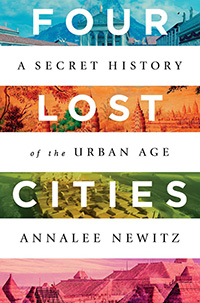 Annalee Newitz, Four Lost Cities: A Secret History of the Urban Age (New York: Norton, 2021), 297pp.
Annalee Newitz, Four Lost Cities: A Secret History of the Urban Age (New York: Norton, 2021), 297pp.
At its peak in the 10th and 11th centuries, Angkor in the Khmer Empire was the world's most populous city with a million residents. By the 16th century, though, the once magnificent kingdom was a "decaying urban grid" that was largely abandoned. Similarly, by the year 1050, Cahokia in southern Illinois "was the largest pre-Columbian city in what later became known as North America, and bigger than Paris at the time." But it too succumbed to urban death. Pompei vanished in 79 CE when the eruption of Mount Vesuvius buried it under twenty feet of ash, and Çatalhöyük in Turkey, which was founded 9,000 years ago, was entirely empty by 5500 BCE.
Why do people abandon their cities? How does it happen, and what are its causes? What lessons might we draw from these ghost cities for our own urban futures? Annalee Newitz pondered these questions when she visited the archaeological remains of these four case studies in lost cities. She summarizes the scholarship about each place. She debunks common myths, like the claim that the French "discovered" Angkor, or ideas about fertility goddesses. As must be the case, there's significant speculation and disagreement among the experts about interpreting these lost cities, especially in re-imagining the everyday lives of ordinary citizens. There are also the dangers of over-interpreting ambiguous artifacts, and of projecting our modern understandings onto ancient social structures, political organizations, and economic systems.
Newitz argues that there's "a common point of failure" in her four examples of urban abandonment: a deadly mix of political instability and climate crisis. These cities didn't just disappear; people "deliberately abandoned them, for good reasons." She rejects Jared Diamond's controversial thesis that civilizations just "collapse."And in her view there's a direct line from the past to the present: "it looks chillingly similar to what cities are enduring in the contemporary world." But her urban autopsies also suggest an equally powerful trend: "human resilience in the face of profound hardship." So, our urban futures are not determined; they depend upon our very human choices.
Dan Clendenin: dan@journeywithjesus.net


